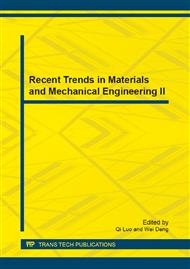[1]
F. Nový, M. Činčala, P. Kopas, O. Bokůvka: Mechanisms of high-strength structural materials fatigue failure in ultra-wide life region. Materials Science and Engineering. ISSN 0921–5093, 2007, Vol. 462, p.189–192.
DOI: 10.1016/j.msea.2006.03.147
Google Scholar
[2]
G. Nicoletto, O. Bokůvka, L. Collini, P. Kopas: Fatigue Resistance in the Very High-cycle Regime. Transaction of FAMENA. ISSN 1333–1124, 2005, Vol. 29, No. 1, p.9–16.
Google Scholar
[3]
M. Balda, J. Svoboda, V. Fröhlich: Using hypotheses for calculating fatigue lives of parts exposed to combined random loads. In: Engineering mechanics. Svratka (2003), p.12–15.
Google Scholar
[4]
A. Carpinteri, A. Spagnoli, S. Vantadori: A multiaxial fatigue criterion for random loading. Fatigue & Fracture of Engineering Materials & Structures. ISSN 1460-2695, 2003, Vol. 26, No. 6, pp.515-522.
DOI: 10.1046/j.1460-2695.2003.00620.x
Google Scholar
[5]
J. Liu, J. Li, Z. P. Zhang: A three-parameter model for predicting fatigue life of ductile metals under constant amplitude multiaxial loading. Journal of Materials Engineering and Performance. ISSN 1059-9495, 2013, Vol. 22, No. 4, pp.1161-1169.
DOI: 10.1007/s11665-012-0197-0
Google Scholar
[6]
V. Kompiš, F. Konkoľ, M. Vaško: Trefftz-polynomial reciprocity based FE formulation. In Computer Assisted Mechanics and Engineering Sciences. ISSN 1232–308X, 2001, Vol. 8, No. 2–3, p.385–395.
Google Scholar
[7]
X. Pitoiset, A. Preumont, A. Kernilis: Tools for a Multiaxial Fatigue Analysis of Structures Submitted to Random Vibrations. Proceedings European Conference on Spacecraft Structures Materials and Mechanical Testing, Braunschweig, Germany, (1998).
DOI: 10.1046/j.1460-2695.2001.00394.x
Google Scholar
[8]
M. Sága, J. Vavro: Contribution to Non-Proportional Multiaxial Fatigue Analysis by FEM. Materials Engineering. ISSN 1335-0803, 2004, Vol. 11, No. 1, pp.143-150.
Google Scholar
[9]
M. De Freitas, L. Reis, B. Li: Evaluation of small crack growth models for notched specimen under axial/torsional fatigue loading. Facta universitatis, Mechanics, Automatic Control and Robotics. ISSN 0354-2009, 2003, Vol. 3, No 13, pp.657-669.
Google Scholar
[10]
M. Sága: Optimising techniques for multiaxial fatigue analysis by FEM. Computational Mechanics, Nečtiny (2002), pp.403-408.
Google Scholar
[11]
A. Sapietová, Dekýš, V.: A Design and Optimization of the Fully Automatic Shunting Mechanism. Advances in Mechanical Design, Springer Science & Business Media (2012), pp.421-427.
Google Scholar
[12]
M. Žmindák, M. Dudinský: Computational Modelling of Composite Materials Reinforced by Glass Fibers. Procedia Engineering Vol. 48 (2012), pp.701-710.
DOI: 10.1016/j.proeng.2012.09.573
Google Scholar


